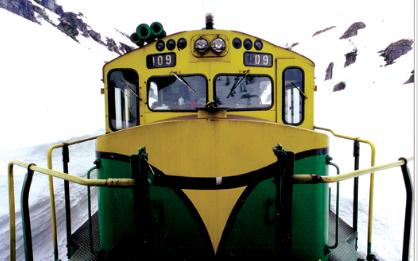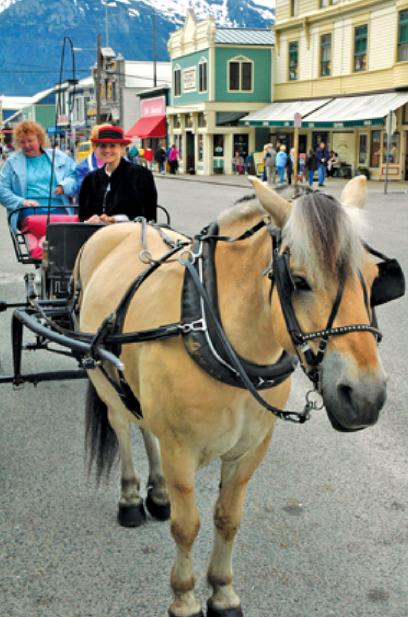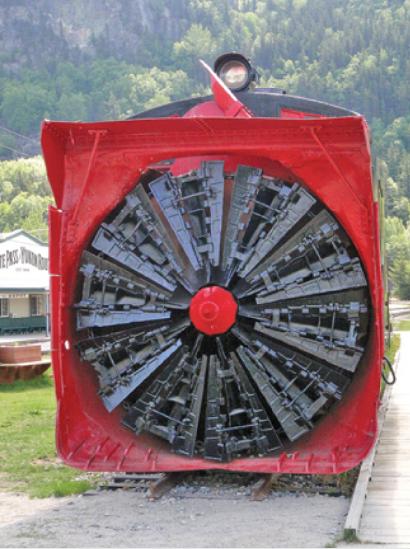 |
|
 |
||
Occasionally in the early 1970s my commercial salmon fishing buddies and I would travel up to Skagway for the weekend, when fishing was closed around Haines, around 15 miles south. The merchants were thrilled to welcome our group, kept their shops and restaurants open late for our business. Dust blew in the empty streets, or if the Alaska state ferry was in, perhaps a few dozen visitors wandered around. It was definitely sleepy. This isn’t what you’ll find today. If you come by cruise ship, you’ll probably arrive with eight or ten thousand other visitors to a town with perhaps 825 permanent residents. Yet surprisingly, this town still retains its charm and the ghosts of the men who passed through in the epic Gold Rush that essentially put Alaska on the map still walk these streets. As much as anything that kept the turn of the 20th century buildings intact – Skagway essentially was built between 1897 and 1900 – was the weather. Buildings that would have rotted away without maintenance in rainy Ketchikan, simply last longer in this much drier, sunnier climate. But it is the drama of ’97 and ’98 that fills this town. Skagway blossomed for but a few years, lawless and rough, then almost disappeared. The gaunt-faced men have passed through to whatever fate The North had in store for them. The town the boom built at the jumping-off place for the Klondike remains, looking much as it did in 1897 and 1898, when some 80 saloons and many professional women were anxious to serve the lonely men on the trail north. Today, Skagway offers a unique experience to visitors. Even the vegetation is different from the rest of Southeast Alaska, because the town is under the influence of the harsher temperature extremes of the interior instead of the milder, cloudier maritime climate elsewhere in the region. Some of the native craftwork available here, especially of ivory, is truly excellent. Note: Only ivory harvested by Native carvers in accordance with federal regulations may be sold legally. Make sure to get a export/transit permit if you buy ivory and plan to transit Canada on your way home. You'll need it to bring the ivory into the United States. If Skagway’s your last stop and you’ve saved your shopping until the end, you’re in luck, the density of shops, particularly jewelry shops (their website, Skagway.com lists 17...) equals that of any other town on your cruise. Shopping’s great, but make sure you take some time between your excursion if you take one, and shopping, to just walk around town, get a sense of the place and of the drama that took place here. A good place to start is the Gold Rush National Historical Park Visitor Center, on the water side of downtown in the White Pass and Yukon Route Railroad station. It gives a great overview of the Gold Rush saga, as well as being in the train station for the WP&YR RR, which is fascinating just by itself. The town of Skagway also operates its own visitor’s center, in the restored and very dramatic Arctic Brotherhood Hall, with its 10,000 or so nailed on pieces of driftwood, probably the most distinctive building in all of Alaska. The Fraternal Order of the Arctic Brotherhood constructed this hall and at least one more in the Yukon Territories as a social and cultural organization to further the interests of the miners. It grew to have substantial political muscle as well, being an early advocate for more political power for Alaskans to manage their own affairs locally rather than through Washington, DC. Pick up a copy of the walking tour map at the AB Hall. It’s got directions up to the Gold Rush Cemetery, the Trail of ‘98 Museum, and other points of interest. It’s definitely worthwhile to walk around with the map as your guide. The hike to Lower Dewey Lake (3 hrs. RT) has a steep stretch at the beginning, but then flattens out for a very pleasant walk. Of course, Skagway’s signature hike is up the old Chilkoot Trail, followed by so many of the men of ‘98. This is way, way more than a pleasant stroll; more like a grueling 4-5 day epic, and that’s in summer, not in the depth of winter with the poorly insulated clothing of the day and 1000 pounds of gear to pack over the summit. If you start up the trail, think about this: many of the men who took it made a dozen or more trips back and forth to ferry their loads if they couldn’t afford to hire a native porter to help them. One good way to see the old trail is an excursion combining a hike up the first few miles with a raft trip back down the river to Dyea. Skagway and Dyea boomed together, but today only Skagway remains, primarily because of the railroad and the docks quickly constructed there. (The tide flats at Dyea were almost a half mile wide on a big low tide, a long, long, way to carry your gear in multiple trips.) What’s interesting about Dyea is this–today the ruins seem really far from the water even at high tide. As it turns out, the land used to be much lower, and hence the water much closer. But as the glaciers that used to cover this whole area thousands of feet deep had only receded recently (well, maybe 10,000 years earlier) the land was experiencing ‘glacial rebound’ to the tune of about a half to three quarters of an inch a year–enough to lift the land 6-7 feet since the Gold Rush and push the waterline back considerably in that flat river delta. Just renting a bike downtown for a few hours is also a pretty mellow way just to explore the town and surrounds. The 10 miles out to Dyea is a pretty nice ride, but at least in 2005 much of the road was unpaved and though we loved the free tour by a ranger around the old townsite, we were really glad when a kind driver offered to run us up to “the top of the hill.” (Which was most of the way back to Skagway.) The helicopter excursions that operate out of near the waterfront are a good way to see the dramatic landscape as well as the Chilkoot Trail. There are a number of different variations most of which include a landing on top of one of the nearby glaciers and a chance to walk around. If you’re ready to dig deep and have never been around dog teams, there is an excursion that includes a dog sled ride. The dogs get really excited then the choppers land and they know that they will be on the trail soon! Save some time at the end of the day to drop in to one of the local watering holes like the Red Onion Saloon, where a lot of the Klondikers tipped a few before they hit the rugged trail. If you want a bit more local color, try Moe’s Frontier Bar, between 4th and 5th. Another highly recommended spot is The Skagway Fish Company, located by the small boat harbor out near the Railroad docks. But most of all, try and take a few moments to think about the men who came, in the fall of 1897, and walked these streets and prepared for the obviously difficult challenges ahead. And the Skagway of those days was very very different from the cheerful busy place you’ll encounter. By all accounts it was a grim place full of hard men. |
Downtown Skagway, about seven in the evening, when most visitors are back aboard ship having dinner. Normally when several ships are in town for the day - there's dock room for five big boys - the streets are a bit more crowded. |
||||||||||||||
 |
|||||||||||||||
Taking the train is the most popular excursion in Alaska. It comes in many flavors - round trip to the top of the pass, R/T to Lake Bennett, Train one way, return by bus, etc. The main thing is ride up or down just to see the rough country that the Klondikers had to struggle over with their thousand pounds of gear and supplies. The train was built too late to help most who came seeking gold, and operated for decades primarily getting revenue from carrying ore for Canadian mines headed for processing. The railroad suspended operations in 1982 when ore prices dropped. But when the big cruise ships started coming to Skagway a few years later, operators saw an opportunity, and reopened, finding and rebuilding classic railroad cars as business improved. |
|||||||||||||||
 |
|||||||||||||||
Don't miss Dennis Corrington's Ivory Museum in his shop, on the left about halfway up Broadway. Dennis was an Iditarod musher and an ivory trader before moving to Skagway. He is an excellent source for Eskimo arts and crafts. |
|||||||||||||||
 |
|||||||||||||||
Early morning approach to Skagway. At the head of a long fjord, it has a distinctly different climate than the rest of SE Alaska, with drier, warmer summers with fewer cloudy days, and colder winters. |
|||||||||||||||
 |
|||||||||||||||
Merchants wasted no time - this classic Alaska gift shop started with the gold rush of 1897-8, and was recently acquired by a jewelry chain who apparently thought better of the totems... Below: there's a full range of excursions here. |
|||||||||||||||
 |
|||||||||||||||
 |
|||||||||||||||
If you're a rail buff, there's a lot of history here - this steam rotary plow had one steam engine just to turn the great rotor , and another locomotive behind that to push the plow! |
|||||||||||||||